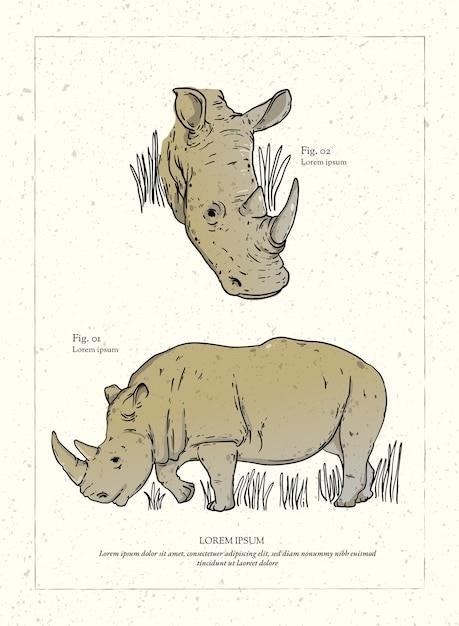Rhinoceros Conservation Status
The global rhinoceros population faces a critical conservation challenge. Recent estimates indicate approximately 18,000 rhinos remain worldwide, distributed across Africa and Asia. Several species are critically endangered, highlighting the urgency of conservation efforts.
Global Population Numbers and Trends
Precise global rhinoceros population numbers are challenging to obtain due to the difficulties in surveying these elusive animals across vast and often inaccessible habitats. However, available data paints a concerning picture. While the overall number is estimated to be around 18,000, this figure masks significant variations among species and subspecies. African rhinos, particularly white rhinos, have seen relative increases in population in certain areas thanks to successful conservation efforts. Conversely, black rhinos, and several Asian species such as the Javan and Sumatran rhinos, remain critically endangered with extremely low population numbers. The Javan rhino, in particular, clings to survival with only a handful of individuals left in the wild. These fluctuating numbers reflect the ongoing struggle against poaching, habitat loss, and other threats. Continued monitoring and robust data collection are vital to track these trends accurately and inform effective conservation strategies.
IUCN Red List Classifications
The International Union for Conservation of Nature (IUCN) Red List provides the most comprehensive assessment of the conservation status of species globally. The classification of rhinoceros species on the Red List varies significantly, reflecting the diverse threats and population trends within the group. Several species are classified as Critically Endangered, indicating an extremely high risk of extinction in the wild. This classification highlights the urgent need for immediate and intensive conservation measures. Other species are categorized as Vulnerable or Near Threatened, signifying a high or moderate risk of extinction, respectively. The IUCN Red List classifications serve as a crucial tool for prioritizing conservation efforts, guiding policy decisions, and mobilizing resources for the protection of these magnificent animals. Regular updates to the Red List reflect ongoing monitoring and research on rhinoceros populations, informing adaptive management strategies.
Major Threats to Rhinoceros Populations
Rhinoceros populations face a multitude of severe threats, primarily driven by human activities. Poaching for their horns remains the most significant and immediate danger, fueled by persistent demand in certain markets. Sophisticated poaching techniques, including the use of advanced technology, pose a considerable challenge to conservation efforts. Habitat loss and fragmentation due to human encroachment, agricultural expansion, and infrastructure development significantly impact rhinoceros survival. This loss of suitable habitat restricts their movement, reduces access to resources, and increases vulnerability to poaching. Human-wildlife conflict, arising from competition for resources and habitat, also contributes to rhinoceros mortality. Furthermore, the impact of climate change, leading to altered rainfall patterns, vegetation shifts, and increased susceptibility to disease, poses a long-term threat to rhinoceros populations. Addressing these multifaceted threats requires a comprehensive and integrated approach involving law enforcement, community engagement, habitat protection, and sustainable land management practices.
Conservation Efforts
Global rhinoceros conservation involves multifaceted strategies⁚ anti-poaching measures, habitat preservation, and community-based initiatives are crucial for their survival and future.
Anti-Poaching Strategies and Technologies
Combating rhino poaching requires a multi-pronged approach leveraging advanced technologies and collaborative strategies. Real-time monitoring systems, utilizing GPS tracking and drone surveillance, provide crucial data on rhino movements and potential poaching threats. These technologies enable rapid response to detected threats, deterring poachers and facilitating timely interventions. Furthermore, sophisticated DNA analysis techniques aid in tracing poached rhino horns back to their origins, disrupting illegal trafficking networks and prosecuting perpetrators. In addition to technological advancements, effective anti-poaching strategies also involve community engagement and the training of skilled rangers equipped with modern weaponry and tactical expertise. Collaborative efforts between governments, conservation organizations, and local communities are essential for successful long-term rhino protection.
Habitat Protection and Management
Protecting and effectively managing rhino habitats is paramount to their long-term survival. This involves establishing and maintaining protected areas, national parks, and reserves where rhinos can thrive with minimal human interference. Careful habitat management practices are crucial, including controlling invasive plant species that compete with native vegetation crucial for rhino foraging. Sustainable grazing practices are implemented to prevent overgrazing and maintain ecosystem balance. Furthermore, habitat connectivity is vital, allowing rhinos to migrate and access resources across a wider landscape, reducing inbreeding and increasing genetic diversity. Corridors linking isolated populations are established to facilitate natural movement and prevent genetic bottlenecks. Research into rhino habitat preferences and requirements informs management strategies, ensuring that protected areas provide optimal conditions for rhino survival and reproduction. Community involvement in habitat protection and sustainable resource management is vital for long-term success.
Community-Based Conservation Initiatives
Community-based conservation is increasingly recognized as a vital component of successful rhino protection strategies. Engaging local communities living near rhino habitats fosters a sense of ownership and responsibility for conservation efforts. This approach involves providing alternative livelihoods to reduce reliance on activities that threaten rhinos, such as poaching or unsustainable land use. Community members are often trained as anti-poaching patrols, providing vital local knowledge and expertise in protecting rhinos within their traditional territories. Educational programs raise awareness about the importance of rhino conservation, promoting responsible behavior and discouraging harmful practices. Furthermore, community participation in ecotourism initiatives generates income for local communities while simultaneously raising awareness about rhinos and their conservation needs. This creates a financial incentive for conservation, fostering long-term commitment and sustainable development. Fair and equitable benefit-sharing mechanisms ensure that local communities directly benefit from conservation efforts, strengthening their commitment to protecting rhinos and their habitats.

Specific Rhinoceros Species
This section details the five extant rhinoceros species⁚ two African (white and black) and three Asian (Javan, Sumatran, and greater one-horned). Each faces unique threats and conservation challenges.
African Rhinoceroses (White and Black)
Africa harbors two rhinoceros species⁚ the white rhinoceros (Ceratotherium simum) and the black rhinoceros (Diceros bicornis). The white rhino, despite its name, is not actually white but gray. Its wider muzzle allows for grazing, distinguishing it from the black rhino, which has a pointed lip for browsing. Historically, both species suffered severe population declines due to poaching for their horns, a practice driven by traditional medicine and other markets. However, thanks to extensive conservation efforts, the white rhino population has shown a significant recovery, though it still faces threats. Conversely, the black rhino, while recovering from near extinction, remains critically endangered with ongoing concerns about its survival. The differences in their feeding habits and habitat preferences contribute to their varying conservation statuses and recovery trajectories. Ongoing anti-poaching measures and habitat protection remain critical to their long-term survival.
Asian Rhinoceroses (Javan, Sumatran, Greater One-Horned)
Asia’s rhinoceroses face an even more precarious situation than their African counterparts. The Javan rhinoceros (Rhinoceros sondaicus), with fewer than 80 individuals remaining in a single Indonesian national park, is the most critically endangered. Habitat loss and poaching continue to decimate this species. The Sumatran rhinoceros (Dicerorhinus sumatrensis) fares little better, classified as critically endangered due to habitat fragmentation and poaching pressures. It’s the smallest rhinoceros species and the only Asian rhino with two horns. In contrast, the greater one-horned rhinoceros (Rhinoceros unicornis), found in Nepal and India, enjoys a more stable, though still threatened, population. While numbers have increased thanks to substantial conservation efforts, these rhinos still face threats from habitat encroachment and poaching. The future survival of all three Asian rhinoceros species hinges on strict anti-poaching measures, habitat preservation, and community engagement.

Future Outlook and Challenges
The long-term survival of rhinoceroses remains uncertain despite significant conservation efforts. Continued poaching, driven by high demand for rhino horn in some Asian markets, poses the most immediate threat. Sophisticated poaching techniques necessitate equally advanced anti-poaching strategies. Habitat loss due to human encroachment and agricultural expansion further complicates conservation. Climate change impacts, such as altered rainfall patterns and increased frequency of extreme weather events, also pose a significant challenge. Securing sufficient funding for long-term conservation initiatives remains a critical obstacle. International cooperation is essential to address the transnational nature of rhino horn trafficking. Effective community engagement and sustainable development initiatives within rhinoceros range states are crucial for long-term success. The future of these magnificent creatures depends on the continued commitment and innovative approaches of conservationists and governments worldwide.